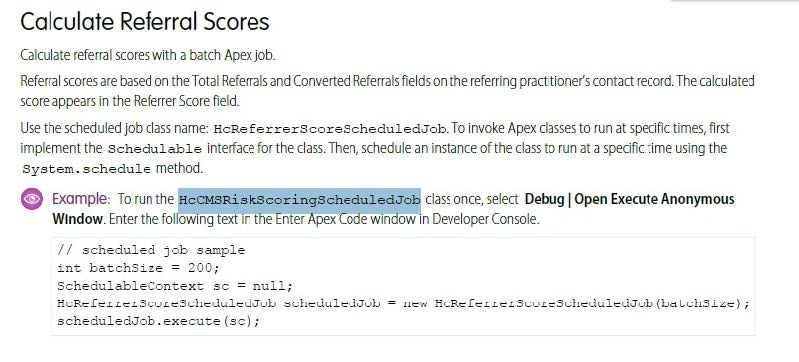Exam Details
Exam Code
:HEALTH-CLOUD-ACCREDITED-PROFESSIONALExam Name
:Salesforce Health Cloud Accredited ProfessionalCertification
:Salesforce CertificationsVendor
:SalesforceTotal Questions
:228 Q&AsLast Updated
:Mar 28, 2025
Salesforce Salesforce Certifications HEALTH-CLOUD-ACCREDITED-PROFESSIONAL Questions & Answers
-
Question 81:
A pharma company wants to leverage Provider Search to help patients find nearby infusion clinics. Which Health Cloud tool should a consultant leverage to drive performance and scalability?
A. Flow for Industries
B. PipelineAnalytics
C. Business Rules Engine
D. Data Processing Engine
-
Question 82:
A customer wants to view and navigate to critical insurance, clinical, and primary care physician information on a patient's profile.
Which Health Cloud capability should a consultant implement?
A. Advanced Patient Card
B. Patient Path
C. Enhanced Highlights Panel
D. Enhanced Timeline
-
Question 83:
Bloomington Caregivers would like toshare patient medication information with an external pharmacy as soon as it's updated in Bloomington Caregivers' Health Cloud system. It would also like to receive an immediate confirmation about any medication interactions from the pharmacy. Which two integration patterns should a consultant recommend? (Choose Two)
A. Industries ETL
B. Platform Event
C. OmniStudio Integration Procedure
D. Apex HTTP Callout
-
Question 84:
A new user story requires an OmniScript to update an existing fieldon a custom SObject. Which two components should a consultant use to satisfy the requirement? (Choose Two)
A. SOQL Query
B. API Actions
C. Integration Procedures
D. DataRaptors
-
Question 85:
A customer wants to leverage dependent intervention tasks as part of their care coordination solution using Integrated Care Management.
Which feature should a consultant configure to accomplish this task?
A. Intervention Templates
B. Action Plan Templates
C. Care Plan Task Templates
D. Industry Template Library
-
Question 86:
Bloomington Caregivers has identified the need to encrypt data to comply with the Health Insurance Portability and Accountability Act (HIPAA).
What are three key considerations when complying with HIPAA regulations using Salesforce Shield in conjunction with Bloomington Caregivers' data strategy? (Choose Three)
A. Ensuring that sensitive data is encrypted both in transit and at rest
B. Configuring data retention policies to ensure that records are retained for the appropriate length of time
C. Using third-party data backup solutions to store backups of sensitive data off-site
D. Implementing audit trails and regularly reviewing them to detect unauthorized access attempts
E. Providing access to third-party auditors to regularly review Shield implementation settings
-
Question 87:
When bringing in the Business identifier for patient record from external system like EHRs, which entity is most suitable to hold that information in Health cloud?
A. Sourcesytem identifier
B. Contacts
C. Account
D. Identifier
-
Question 88:
In which two ways can an administrator ensure that Patient Risk scores are recalculated periodically? (Choose Two)
A. Setup a scheduled Apex batch job.
B. Use the CMSrecalculation API
C. Use a third party API to recalculate CMS risk score
D. Setup a Apex batch job and run the job manually
E. Create a Healthcare Provider enrollment flow.
-
Question 89:
A MedTech company needs to manage its run rate business to ensure contract compliance for its customers. Which two features of Health Cloud should a consultant recommend the company use? (Choose Two)
A. Remote Device Monitoring
B. MedTech Accelerator
C. Advanced Account Forecasting
D. Sales Agreements
-
Question 90:
In which two ways can Life Science organizations capture consent from enrollees of Care Program? (Choose Two)
A. By engaging in a web chat with an agent who presents consent forms in chat window.
B. By sending an email that then create a case using email-to-case.
C. By talking to an agent via phone who then enrolls the patient
D. By submitting consent Via SMS using Einstien Chat bot.
E. By using a Self-Service portal via a Community.
Related Exams:
201-COMMERCIAL-BANKING-FUNCTIONAL
Salesforce enCino 201 Commercial Banking FunctionalADM-201
Administration Essentials for New AdminsADM-211
Administration Essentials for Experienced AdminADVANCED-ADMINISTRATOR
Salesforce Certified Advanced AdministratorADVANCED-CROSS-CHANNEL
Salesforce Advanced Cross Channel Accredited ProfessionalADX-201
Administrative Essentials for New Admins in Lightning ExperienceADX-271
Salesforce Certified Community Cloud ConsultantAGENTFORCE-SPECIALIST
Salesforce Certified Agentforce SpecialistANC-301
Working with Data and Dashboards in Einstein AnalyticsB2B-COMMERCE-ADMINISTRATOR
Salesforce Accredited B2B Commerce Administrator
Tips on How to Prepare for the Exams
Nowadays, the certification exams become more and more important and required by more and more enterprises when applying for a job. But how to prepare for the exam effectively? How to prepare for the exam in a short time with less efforts? How to get a ideal result and how to find the most reliable resources? Here on Vcedump.com, you will find all the answers. Vcedump.com provide not only Salesforce exam questions, answers and explanations but also complete assistance on your exam preparation and certification application. If you are confused on your HEALTH-CLOUD-ACCREDITED-PROFESSIONAL exam preparations and Salesforce certification application, do not hesitate to visit our Vcedump.com to find your solutions here.
